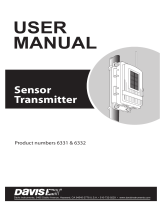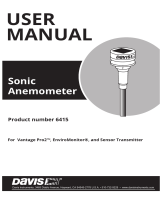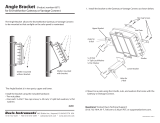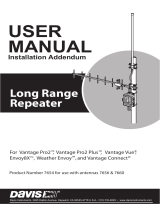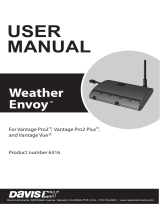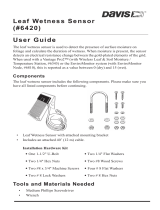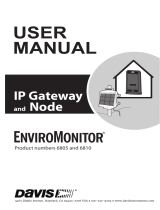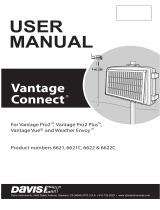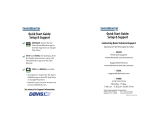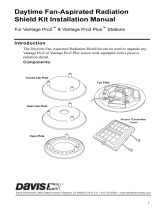Page is loading ...

1
Temperature Probes with 25-foot (7,6 m) cable
Product numbers 6475 & 6477
Your temperature probe may be used with the
Sensor Transmitter or the wireless Weather Envoy.
It can also be used with an EnviroMonitor Node
with the RJ Connector Node Adapter (#6860).
The sensor may be used to measure air, soil, or
water temperatures.
Tools and Materials Needed
You may need some of the following tools and
materials to complete your installation.
• Shovel or spade to dig hole for sensor if using as a soil temp sensor
• Metal or plastic conduit to protect cable from rodents
• Cable clips or weather-resistant cable ties with screw holes or other means for
mounting to secure cable
Testing the Sensor
Test the sensor before installing it.
1. Attach the sensor cable to the appropriate connector on the Envoy, Sensor
T
ransmitter or Node. (Consult your product’s User Guide for more information.)
2. Make sure you are getting an outside temperature reading on your console or
other receiver. The sensor will report as “inside temperature.”
Choosing a Location for the Sensor
Use the suggestions below to find a suitable location in which to mount the sensor.
Care taken in choosing a location improves the accuracy, reliability, and durability of
the sensor. The ideal location would be on the NORTH SIDE of a building (south side
in the Southern Hemisphere).
Note: When choosing a location for the sensor you should take into consideration the objects
nearby. Objects which heat up in direct sunlight or produce radiative cooling effects may
affect temperature readings by changing the surrounding air temperature.
Look for a location which satisfies the following requirements:
• Place the sensor in a location where it will not be in direct sunlight and where it
will have limited exposure to reflected sunlight.
• Limit the exposure of the sensor to the open night sky.
• Place the sensor at least 5 feet from man-made sources of heat.
• Keep the sensor away from AC power lines.
• If possible, place the sensor at least 5 feet from any surface which is exposed to
direct sunlight because the heat from this surface may af
fect air temperature
readings in the vicinity.
• Place the sensor in a location at least 10 feet away from lights or lamps.
• If you are unsure about a location's exposure to the night sky, check for dew at that
location on a light dewy morning. If the area is dry
, the location should work well.

2
• Keep the sensor and most of the cable at least 10 feet from 110 Vac, 60Hz utility
power. Do not run the sensor cable parallel to house wiring. Mount the sensor at
least 30 feet from high-voltage power lines and transformers.
Installing the Sensor
The illustration below shows typical installations for the Envoy in a Davis
Universal Shelter (product no. 6618) mounted on a pole (left) and in a Sensor
Transmitter (right) mounted on a pole.
SENSOR
INTERFACE
MODULE
UV SUN
RAIN WIND
TEMP
HUM
+
-
Mounting the Sensor
Depending on your use for this sensor, you may install it following the suggestions
below:
• For air temperature, use a cable tie, cable clip, or electrical tape to attach the
cable to a building, post, antenna mast, or other surface (make sure the sensor
itself is not in contact with the building’
s surface). Consult the Radiation Shield
manual for instructions on installing the sensor in a Radiation Shield.
• For soil temperature, bury the sensor at a depth suitable for your purposes.
Where the cable runs along the ground, use metal or plastic conduits to protect
the cable from rodents.
• For water temperature, drop the sensor into the water at a depth suitable for
your purposes. If the cable runs along the ground at any point, use metal or
plastic conduits to protect the cable from rodents.

3
In any case, to prevent fraying or cutting of the sensor cable where it is exposed to
weather, it is important that you secure it so it doesn’t whip about in the wind.
For example, you might want to use cable clips or weather
resistant cable ties to secure the cable. Place clips or ties
approximately every 3 to 5 feet (1 to 1.6 m). Do not use
metal staples or a staple gun to secure cables. Metal
staples — especially when installed with a staple gun —
have a tendency to cut the cables.
Note: When running the sensor cable, try not to tug on the cable in such a way as to loosen
the connections. Also, make sure the sensor cable is not so taut that the connection
may loosen or pull free due to the strain. Many sensor problems occur because cable
connections come loose.
Sensor Output Specifications
Outside Temperature (Air)
Resolution and Units . . . . . . . . . . . . . . . . . . . . . . . .1°F or 1°C (user-selectable)
Range. . . . . . . . . . . . . . . . . . . . . . . . . . . . . . . . . . . .-40° to +150°F (-40° to +65° C)
Sensor Accuracy . . . . . . . . . . . . . . . . . . . . . . . . . . .±1°F (±0.5°C) typical
Update Interval
When used with a Sensor Transmitter . . . . . . . . .10 seconds
When used with an Envoy . . . . . . . . . . . . . . . . . .1 minute

Temperature Probes, #6475 & #6477 Document Part Number: 7395.248; Rev. E, 2/22/19
Vantage Pro and EnviroMonitor are registered trademarks of Davis Instruments, Hayward, CA.
©2019 Davis Instruments Corp. All rights reserved.Information in this manual is subject to change without
notice. RoHS compliant. Davis Instruments Quality Management System is ISO 9001 certified.
3465 Diablo Avenue, Hayward, CA 94545-2778 U.S.A
.
510-732-9229 • Fax: 510-732-9188
E-mail: [email protected]
www.davisinstrumentscom
®
Contacting Davis Technical Support
If you are having problems with the sensor, first check all cable connections.
Connections should be firmly seated in the jacks and plugged in straight. If you
think a connection may be faulty, try jiggling the cable while looking at the
display. If a reading appears intermittently on the display, the connection is faulty.
If you are unable to solve the problem, please call Davis Technical Support. We’ll
be glad to help. Most questions can be answered over the phone. You can also e-
mail us for support or visit our web site.
Note: Please do not return items to the factory for repair before calling to get a Return
Materials Authorization number.
Online
www.davisinstrumentscom
See the Weather Support section for copies of user
manuals, product specifications, application notes,
software updates, and more.
E-Mail [email protected]
Telephone
(510) 732-7814
Monday - Friday, 7:00 A.M.- 5:30 P.M., Pacific Time
/
